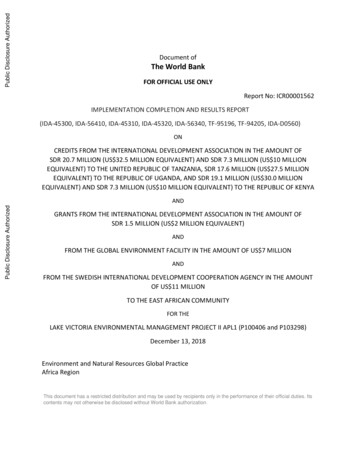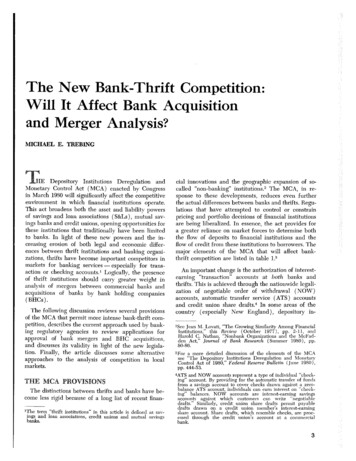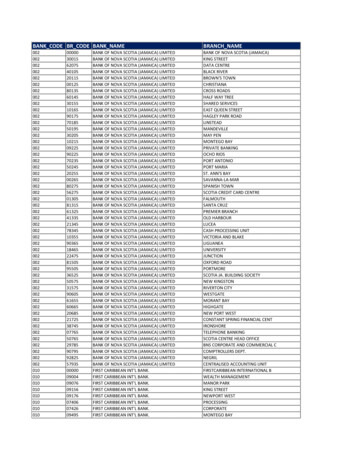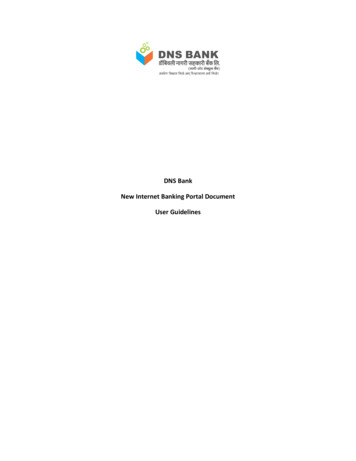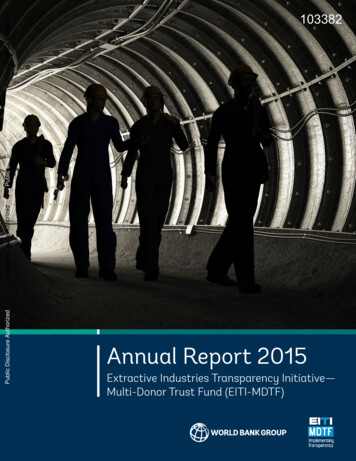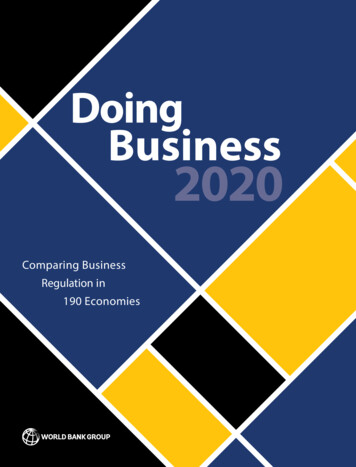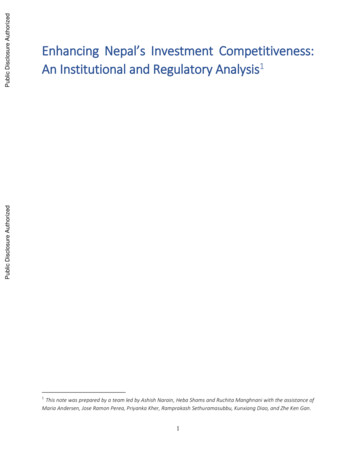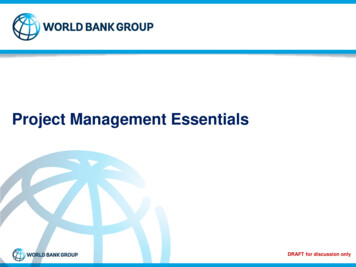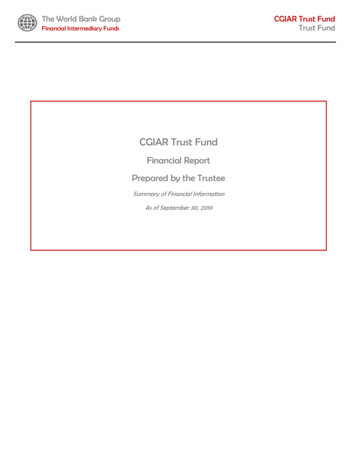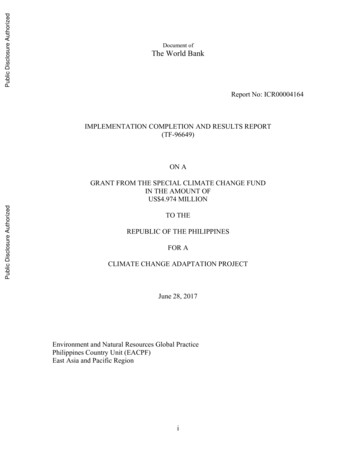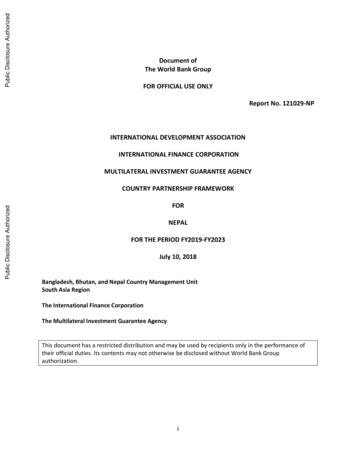
Transcription
Public Disclosure AuthorizedDocument ofThe World Bank GroupFOR OFFICIAL USE ONLYPublic Disclosure AuthorizedPublic Disclosure AuthorizedReport No. 121029-NPINTERNATIONAL DEVELOPMENT ASSOCIATIONINTERNATIONAL FINANCE CORPORATIONMULTILATERAL INVESTMENT GUARANTEE AGENCYCOUNTRY PARTNERSHIP FRAMEWORKFORNEPALFOR THE PERIOD FY2019-FY2023July 10, 2018Bangladesh, Bhutan, and Nepal Country Management UnitSouth Asia RegionPublic Disclosure AuthorizedThe International Finance CorporationThe Multilateral Investment Guarantee AgencyThis document has a restricted distribution and may be used by recipients only in the performance oftheir official duties. Its contents may not otherwise be disclosed without World Bank Groupauthorization.i
The date of the last Performance and Learning Review was February 21, 2017CURRENCY EQUIVALENTS(Exchange Rate Effective June 11, 2018)Currency Unit Nepali Rupee (NPR)US 1 NPR 107.87FISCAL YEARJuly 16 – July 15Vice President:Director:Country Manager:ResidentRepresentative:Task Team Leader:IDAHartwig SchaferQimiao FanFaris Hadad-ZervosIFCNena StoiljkovicMengistu AlemayehuWendy WernerJuri Oka/Bigyan PradhanRehan RashidPia Trivedi/Rafael DomingueziiMIGAKeiko Honda (EVP/CEO)Merli BaroudiPersephone Economou
ABBREVIATIONS AND ACRONYMSADBAFAIIBASAAsian Development BankAdditional FinancingAsian Infrastructure Investment BankAdvisory Services and AnalyticsATMBIMPAutomated Teller MachineBridges Improvement and MaintenanceProgramCapital Adequacy RatioCatastrophe Deferred Drawdown OptionClimate ChangeCompliance Cost AnalysisCountry Economic MemorandumContingent Emergency Response ComponentCompletions and Learning ReviewCountry Partnership FrameworkCommunist Party of NepalCountry Partnership StrategyCountry Private Sector DiagnosticCivil Society OrganizationDoing BusinessDeposit and Credit Guarantee FundDepartment of Foreign Affairs and TradeDepartment for International DevelopmentDemographic and Health SurveysDisbursement Linked IndicatorDevelopment PartnerDevelopment Policy CreditDevelopment Policy OperationDisaster Risk ManagementEarthquake Housing Reconstruction ProjectEnvironment and Social AFKilometerKorea International Cooperation AgencyMulti-Donor Trust FundMaximizing Finance for DevelopmentMicrofinance InstitutionMiddle-Income CountryMultilateral Investment Guarantee AgencyManagement Information SystemMultidimensional Poverty IndexMicro, Small and Medium EnterpriseMedium-Term Expenditure FrameworkMegawattNepal Bank LimitedNationally Determined ContributionNational Electric AuthorityNepal Electricity Regulatory CommissionNepal India Regional Trade and TransportNon-Lending Technical AssistanceNepal RupeeNepal Rastra BankNational Women CouncilOpen Defecation FreeOperation and MaintenanceProject for Agriculture Commercialization andTradePoverty Alleviation FundPCAPDOPrompt Collective ActionProject Development ObjectivePEFPEFAPandemic Emergency FacilityPublic Expenditure and FinancialAccountabilityPublic Financial ManagementProgram-for-ResultsPerformance and Learning ReviewPower Purchase AgreementPublic Procurement Monitoring OfficePublic-Private PartnershipPrivate Sector WindowRisk and Resilience AssessmentSouth Asia Regional Integration in Trade andInvestmentSouth Asia Water InitiativeSystematic Country DiagnosticEVMFAOEnergy Sector Management AssistanceProgramEuropean UnionEnhanced Vocational Education and TrainingProjectEffective Vaccine ManagementFood and Agriculture OrganizationFCPFFDIFIFITTAFSAPFWGFYGBVGESIForest Carbon Partnership FacilityForeign Direct InvestmentFinancial InstitutionForeign Investment ActFinancial Sector Assessment ProgramFederalism Working GroupFiscal YearGender Based ViolenceGender Equality and Social enhouse GasGesellschaft für structure Sector Assessment ProgramInvestment Project FinancingImplementation Status ReportIrrigation and Water Resources ManagementProjectJapan International Cooperation AgencyJoint Implementation Plan
INDCGlacial Lake Outburst FloodsGross National IncomeGovernment of NepalHigher Education Reform ProjectHealth, Nutrition and PopulationInternational Center for Integrated MountainDevelopmentInvestment Climate Reform ProgramInformation, Communication and TechnologyInternational Development AssociationInternational Development Partners GroupInternational Fund for AgricultureDevelopmentInternational Finance CorporationInternational Labour OrganizationInternational Monetary FundIntended Nationally Determined ContributionivSDCSEZSMESORTTATFSwiss Development CooperationSpecial Economic ZoneSmall and Medium EnterpriseSystematic Operation Risk-rating ToolTechnical AssistanceTrust FundUNUSUSAIDVDCWASHUnited NationsUnited StatesUnited States Agency for InternationalDevelopmentVillage Development CommitteeWater Supply, Sanitation and HygieneWBWBGWFPWSSWorld BankWorld Bank GroupWorld Food ProgramWater Supply and Sanitation
FY2019-2023 COUNTRY PARTNERSHIP FRAMEWORK FOR NEPALTable of ContentsI.INTRODUCTION . 1II.COUNTRY CONTEXT AND DEVELOPMENT AGENDA. 2III.WORLD BANK GROUP PARTNERSHIP FRAMEWORK . 7IV.MANAGING RISKS TO ACHIEVING CPF RESULTS . 22Annex 1. Nepal CPF (FY2019-2023) Results Matrix. 24Annex 2: Nepal Country Partnership Strategy FY2014-2018 - Completion and Learning Review. 42Annex 3. Selected Indicators of Bank Portfolio Performance and Management . 76Annex 4: Operations Portfolio (IBRD/IDA and Grants) . 77Annex 5: IFC Committed and Disbursed Outstanding Investment Portfolio . 78Annex 6. IFC Advisory Services – Portfolio Project FY19-23 . 79Annex 7: Summary of the Country Level Gender Equality and Social Inclusion Assessment . 81Annex 8. Summary of Development Partner Coordination . 84Annex 9. Summary of Stakeholder Consultations . 87Annex 10. Nepal Implementation Action Plan for use of IDA18 Risk Mitigation Regime Window . 89v
I.INTRODUCTION1.The Country Partnership Framework (CPF) covering the five-year period of FY2019-2023 comesat a time of historic transformation in Nepal. The signing of the 2006 Comprehensive Peace Agreementended a 10-year conflict that came at a significant cost of lives and foregone economic development. Sincethen, Nepal has gone through lengthy and complex transitions towards a new Constitution in 2015 thatestablishes a federal structure. By the end of 2017, elections were successfully held at the federal, state,and local tiers. There is a newfound optimism for greater political stability, inclusion, good governanceand sustainable growth. The new federal structure presents unprecedented opportunities to reset Nepal’sdevelopment storyline, as raised in the Systematic Country Diagnostic (SCD)1. At the same time, the shiftto federalism poses new challenges and source of fragility, given the heightened popular aspirations andexpectations. Key challenges include the need to clarify the functions and accountabilities of the federal,state, and local governments; deliver basic services and maintain infrastructure development; create aconducive environment for the private sector; and address governance weaknesses that may worsen inthe early years of federalism.2.The implementation of the CPF will need to balance flexibility and steady focus on the country’stransition to a federal state with the quest for higher and sustained growth with poverty reduction andinclusive development. To that end, the CPF focuses on three transformative engagement areas: (1)public institutions for economic management, service delivery and public investment; (2) private sectorled jobs and growth; and (3) inclusion for the poor, vulnerable, and marginalized groups, with greaterresilience against climate change, natural disasters, and other exogenous shocks.3.The CPF builds on the FY2014-2018 Country Partnership Strategy (CPS) and additional analysesto identify new challenges and opportunities in the coming period. The CPF focus areas have emergedfrom nationwide consultations for, and analysis of the SCD. They are further refined by exploring Nepal’sdrivers of fragility, its new federalism context, the World Bank Group’s (WBG) comparative advantage,and lessons learned. Equally important, the CPF focus areas are aligned with the government’s ownpriorities in Envisioning Nepal 2030, and the 14th Periodic Plan for FY2017-2019. The CPF incorporates thefindings of the CPS Completion and Learning Review (CLR), the Risk and Resilience Assessment (RRA), andother analytical work2 including the early findings of the Country Private Sector Diagnostic (CPSD), and theInfrastructure Sector Assessment Program (InfraSAP). The indicative resources available under IDA18(FY2018-2020) are about US 1.3 billion3, including US 300 million from the IDA Risk Mitigation Regimefor which an Implementation Action Plan was prepared 4. The International Finance Corporation (IFC) aimsto commit about US 800 million to US 1.2 billion. The Multilateral Investment Guarantee Agency (MIGA)has no pre-determined envelope for guarantees over the CPF period, but is actively seeking opportunitiesto support foreign private investment into Nepal and may make use of the IDA IFC/MIGA Private SectorWindow (PSW) and the MIGA Guarantee Facility to de-risk eligible projects.1The Nepal Systematic Country Diagnostic- A New Approach to Federal Nepal (Report Number 123958, World Bank 2018).Core diagnostics include Moving Up the Ladder (World Bank 2016), Climbing Higher (World Bank 2016) and Country EconomicMemorandum (World Bank 2017).3 Referenced IDA18 volumes are indicative. Actual PBA allocations will be determined annually during the FY18-20 period andwill depend on: (i) total IDA resources available; (ii) the number of IDA-eligible countries; (iii) the country’s performance rating,per capita GNI, and population; and (iv) the performance and other allocation parameters for other IDA borrowers.4 The use of the IDA Risk Mitigation Regime is summarized in the Implementation Action Plan for the IDA Risk MitigationRegime included as Annex 10.21
II.COUNTRY CONTEXT AND DEVELOPMENT AGENDAOverview4.Nepal’s transition to a federal state is expected to profoundly impact its future. Since the mid20th century, Nepal has struggled to move away from a feudal past where power and resources wereconcentrated, and where the state was unable to meet the people’s needs. With a diversity of castes,ethnicities and languages, the country is also characterized by a stark topography ranging from theHimalayas in the north to the plains in the south, and by formidable impediments to connectivity thathave left many communities isolated. The country was in conflict from the mid-1990s until the signing ofthe 2006 Comprehensive Peace Agreement. Since then, Nepal has gone through multiple transitions andtwo Constituent Assemblies until the 2015 Constitution introduced the three-tier structure for a newfederal state. The shift to federalism has been a response to the central government’s inability to deliveran inclusive contract called for, especially by the historically marginalized people5. Political instability andweak public institutions have constrained economic growth, while progress in poverty reduction, andshared prosperity was attributed mainly to remittances. Nepal successfully completed federal, state. andlocal elections in 2017, paving the way for a new federal system.Political Context5.In a departure from the past, greater political stability is expected that provides a basis for apositive shift in Nepal’s development path. Over the last decade, Nepal experienced frequentgovernment turnover and political fragmentation with a considerable toll on investment, quality of publicinstitutions, growth and development. The 2017 elections represented a significant turning point. Localelections were held after 20 years filling a void in popular representation. The elections also resulted in,for the first time in Nepal’s parliamentary history, a super-majority coalition government with the twoleading coalition parties merging to become the Nepal Communist Party in May 20186. Thesedevelopments have generated a sense of unprecedented political stability and policy predictability.6.At the same time, the transition to federalism poses significant challenges. The country facesthe daunting task of adapting to a three-tier structure in the face of weak and often-nonexistentinstitutions at the state and local levels. Ministries have been merged, the civil service is beingrestructured, and approximately 110 new laws must be enacted and a further 300 amended in line withthe 2015 Constitution. Functions across the three tiers of government, and the revenue sharing and fiscaltransfer arrangements are being defined. The new structure also requires substantial investment insetting up offices; improving infrastructure connectivity between federal, state, and l
10.07.2018 · (Exchange Rate Effective June 11, 2018) Currency Unit Nepali Rupee (NPR) US 1 NPR 107.87 FISCAL YEAR July 16 – July 15 IDA IFC MIGA Vice President: Director: Country Manager: Resident Representative: Task Team Leader: Hartwig Schafer Qimiao Fan Faris Hadad-Zervos Juri Oka/Bigyan Pradhan Nena Stoiljkovic Mengistu Alemayehu
